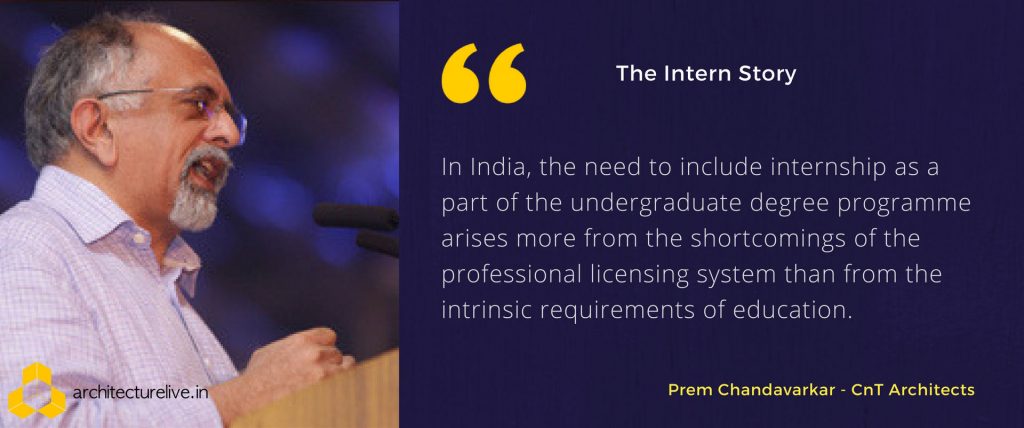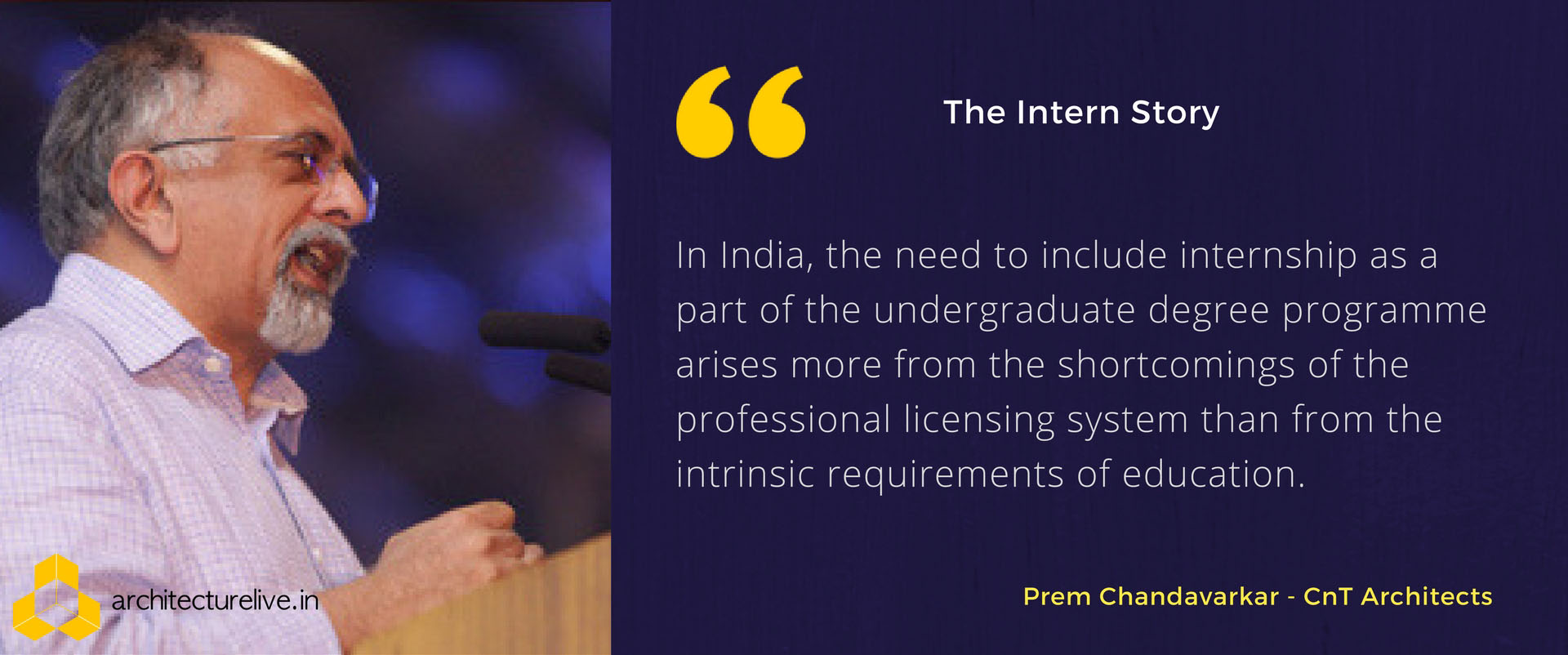Student internship is a quintessential part of an architectural education. However, it is increasingly becoming an unmitigated ordeal for many within the community. Affecting both students and practicing architects, the workforce imbalance and issues of ineptitude have created an unfavourable – and often exploitative – situation.
Inviting the opinions of architects, educators and students, we strive to start a conversation about what can be done to improve this situation. Below, Prem Chandavarkar of CnT Architects ponders upon the feasibility of including internships in architectural education.

An undergraduate degree in architecture can be of two types: professional or non-professional. The professional degree is a sufficient academic qualification for obtaining a legal license to practice architecture. With the non-professional degree, a further graduate degree is needed to qualify for a professional license, but the degree can be applied to non-practicing work allied with architecture, such as journalism, history, academia, or work in a practice at a level below that of partnership.
Practically all architectural undergraduate programmes in India provide professional degrees, and are ten semesters (five years) in length. Therefore, this analysis will confine itself to Indian professional degree programmes, of which all demand that internship in a design practice constitute a part of the programme. There are two models that are followed. The first – which had been the dominant model until quite recently – calls for a semester-long internship, usually in the 7th or 8th semester. The second, a more recent introduction, doubles the internship duration to two semesters at the end of the course: that is the 9th and 10th semesters. Both models treat the necessity of internship as axiomatic, and it is this axiom I seek to deconstruct here.
The axiom rests on four underlying assumptions:
- The purpose of a college is to make graduates employable in practice.
- Ten semesters are more than the necessary time a student needs to spend within college, and one or two semesters can be easily spared out of this to prioritise the internship.
- Exposure to design practice is a prerequisite to acquiring a license to practice.
- The practical exposure gained in an office is a necessary part of the training required to qualify an architect as the holder of a professional degree.
I examine these assumptions one by one.
The College Should Make Graduates Employable in Practice
This is a commonly heard refrain, and one that is deeply troubling. A practice is easily positioned to cover gaps in technical exposure in young graduates. All one needs to do is apprentice the young architect with a senior professional who mentors her/him – if the youngster is a committed learner, within a few months she/he will reach the ability to work independently. However, a practice is not equipped to cover gaps in the ability to think creatively, rigorously, and independently. The kind of mentoring needed here is difficult to absorb within the inherent routines of the profession, and only colleges can lay the foundations for this ability.
What happens when practices are only able to find graduates whose abilities are technical rather than creative and critical? The practice finds it difficult to differentiate itself, and becomes just like any other. An undifferentiated practice becomes what economists define as a commodity: a good or service that cannot be effectively differentiated by qualitative measures, and is primarily differentiated quantitatively, with the dominant measure being price.
This breeds the situation we find today in India: a small handful of self-motivated creative practices, and a majority that is driven to undercut each other in the fees they quote. Education’s desire to serve practice, if made a dominant goal, will only undermine it in the long run. Colleges must realize that their primary obligation is toward the discipline of architecture, and not toward the practice of architecture.
One or Two Semesters Can Easily Be Spared for Internship
There is a historical reason for professional degree programmes to span over five years. Learning design is primarily learning by doing, rather than learning by understanding – therefore, the core of architectural education has always been the design studio, where one learns design by personally doing design. Learning by doing is a process that cannot be easily compressed in time. Going by international standards for professional degrees, the year-by-year stages through which this process evolves – that necessitate five years – are:
- Year 1: Supplement verbal and linear logic with visual and associative logic. Understand design process through basic design exercises. Learn basics of theory and history of design. Develop confidence for creative exploration, rather than be preoccupied with being correct. Develop spontaneity of thinking with one’s hand, and not just with one’s brain.
- Year 2: Learn to carry out simple architectural design projects, gradually moving to how design can enrich life in the way it captures propositional value.
- Year 3: Extend architectural design abilities by learning to design complex projects within an impactful context.
- Year 4: Extend design abilities to be able to handle complexity, context and scale, learning how to organise multiple buildings on a site, and the links between large sites, their ecology, and how design can respect the site.
- Year 5: Prior to graduation, use the thesis project to develop one’s identity as an architect, taking a specific position on the contribution one aspires to make to the discipline.
Each of these steps is challenging, complex, and difficult to handle in less than two semesters. Moreover, they need focus within a freedom that is possible only in college, distanced from the commercial and political exigencies of practice. Hence, all of this time of ten semesters must be within the college. We should take heed of the rest of the world where any academic programme that is less than ten semesters within college is not considered a professional degree.
Exposure to Design Practice is a Prerequisite to Acquiring a License to Practice
This is unquestionable, as one should not acquire a license to practice architecture without practical experience. But it does not necessarily follow that this experience must come while still in college, or that one or two semesters is a sufficient duration for acquiring it. Here too, there is valuable precedent in many parts of the world, where – unlike the situation in India – the degree is not a sufficient qualification for acquiring a license to practice. After obtaining a degree, it is necessary to work in a firm for two to three years, and only after acquiring the necessary experience is one qualified to sit for a licensing examination.
The examination is unconnected to the degree, and is typically administered by a body that is not connected with regulating education. The examination does not seek to check the creative or philosophical abilities of candidates – the focus lies more on assessing the ability to design as per building codes, and understanding of construction, structure, building utilities, and standards of professional practice. One must pass this examination to acquire a license to practice architecture, ensuring that all licensed architects start with a minimum of two to three years of work experience.
In India, the need to include internship as a part of the undergraduate degree programme arises more from the shortcomings of the professional licensing system than from the intrinsic requirements of education.
Office Exposure is a Necessary Part of Undergraduate Education
This rests on the assumption that exposure to the practical dimension of design is necessary for completing the set of abilities of a graduating architect. This assumption is unquestionable, but its corollary that this exposure can only be found in an office is erroneous. The theoretical and practical dimensions are not to be studied in isolation: the key is how one integrates them in the design process.
Architecture students need to learn that design does not spring solely from their creative and intellectual abilities. The inherent tectonic logic of structure, material, construction sequence, and utilities also play a role in shaping the design. The quality of a design springs from the elegance with which this integration is achieved. Practices are not an environment that can provide this mentoring – it can only be taught through the continuous guidance possible in an academic design studio.
If the intern comes without having learnt this integration, her/his utility in an office is very low. The intern is thus assigned the lowest level of technical tasks, with little guidance on how these tasks connect to wider issues. Students of architecture remain largely deprived of effective training in incorporating a practical dimension to the design process.
Conclusion
While still in college, a student may voluntarily intern in an office during vacations. This should, of course, be allowed and encouraged. But making an internship a mandatory segment of a professional degree programme only serves to undermine the quality of education provided. As a consequence, both the student and the discipline suffer.
Internship should be made a part of the licensing procedure rather than the degree programme. Colleges should realize they must teach the student how to integrate the practical, creative, and theoretical dimensions. Mandatory internships deprive them of the time required to do this, and allow them to abdicate a crucial part of their responsibility to practices.
 Prem Chandavarkar is the managing partner of CnT Architects, an architectural and interior design practice based in Bangalore, India. He received his training from the School of Planning and Architecture, New Delhi, India (BArch ‘78) and the University of Oregon (MArch ‘82). Prem is a former executive director of Srishti School of Art Design and Technology in Bangalore. He is an academic advisor and guest faculty at Indian and international colleges of architecture. Besides his design practice at CnT, he writes and lectures on architectural and interior design, urbanism, art, cultural studies and education. You can read his essays about Architecture and more on his blog.
Prem Chandavarkar is the managing partner of CnT Architects, an architectural and interior design practice based in Bangalore, India. He received his training from the School of Planning and Architecture, New Delhi, India (BArch ‘78) and the University of Oregon (MArch ‘82). Prem is a former executive director of Srishti School of Art Design and Technology in Bangalore. He is an academic advisor and guest faculty at Indian and international colleges of architecture. Besides his design practice at CnT, he writes and lectures on architectural and interior design, urbanism, art, cultural studies and education. You can read his essays about Architecture and more on his blog.









3 Responses
Prem, Thank you for this great article which I read with great interest. Needless to say that I completely agree with your line of reasoning.
And as chairperson of the Architects Registration Board I have learnt a few things which I would like to include in my interview with the aspiring architects.
Well explained and the dual responsbilty has to be understood by both the parties, nterns and providers. Th other major
impediment is lack of clear direction by IIA and COA.
The programming of Architectural internship in India, is by-product of how the syllabus is laid out…and the syllabus that is laid out makes the education exam centric than, a creative journey of 5 years.
We try to finish everything in laid out fashion, where everything is defined rigidly.
A student needs time to grow himself in the creative space in terms of time and performance…and this requires rigorous but spaced out syllabus, which gives student freedom to frame the thoughts and take creative risks to think without assuming, this is what is going to come in exam!
The testing of skills in Architecture are…simply the ways a student learns to solve an Architectural problem. This involves a process of meeting, talking, discussions, Arguments, sleep/deprivation, doing, listening, reading and reading…travelling…so on…
and it cant be solved except by doing things in a spaced out fashion…
By spaced out fashion, I mean…integrating everything towards Architectural design, making it nucleus of everything that is being taught in yearly fashion…The semester system has allowed inclusion of more subjects, but it has made the entire process very hasty and automatic…All we achieve is that student goes through more subjects, nothing adequate, nor even design process…
To bring innovation in Architectural solutions and thought process…in academic time, the student must have time and means to explore…
When we come to Architectural Internship, we see it as something, time bound with definite results…Architectural internship needs not be time bound but results oriented…and so it must be disconnected with Academic process…and student under probation, until certain personal/institutional objectives, the student may be made eligible for licensing…
The student, doing internship in Academic time of 5years, can be taken as part of Academic syllabus, where student takes a break from usual pattern of thinking…and also finds space to think and explore…
All we need to probably cancel, modify, shorten and widen, merge and redefine few subjects…
As we all must agree…none of us are right individually…but collective we have to become right…